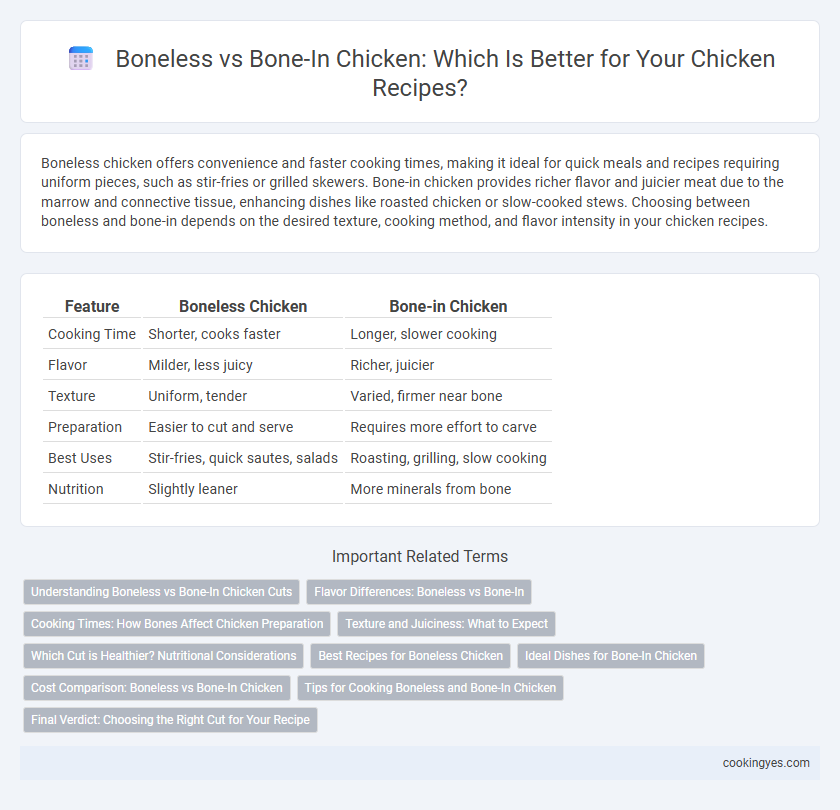Boneless chicken offers convenience and faster cooking times, making it ideal for quick meals and recipes requiring uniform pieces, such as stir-fries or grilled skewers. Bone-in chicken provides richer flavor and juicier meat due to the marrow and connective tissue, enhancing dishes like roasted chicken or slow-cooked stews. Choosing between boneless and bone-in depends on the desired texture, cooking method, and flavor intensity in your chicken recipes.
Table of Comparison
| Feature | Boneless Chicken | Bone-in Chicken |
|---|---|---|
| Cooking Time | Shorter, cooks faster | Longer, slower cooking |
| Flavor | Milder, less juicy | Richer, juicier |
| Texture | Uniform, tender | Varied, firmer near bone |
| Preparation | Easier to cut and serve | Requires more effort to carve |
| Best Uses | Stir-fries, quick sautes, salads | Roasting, grilling, slow cooking |
| Nutrition | Slightly leaner | More minerals from bone |
Understanding Boneless vs Bone-In Chicken Cuts
Boneless chicken cuts, such as breasts and thighs, offer quicker cooking times and ease of preparation, making them ideal for recipes requiring uniform cooking and minimal handling. Bone-in cuts like drumsticks and whole wings provide richer flavor and moisture due to marrow and connective tissue, which also helps retain tenderness during slow cooking methods. Understanding these differences ensures choosing the best chicken cut for specific recipes, optimizing texture, taste, and cooking efficiency.
Flavor Differences: Boneless vs Bone-In
Bone-in chicken offers richer flavor and juicier texture as the bones help retain moisture and infuse the meat with depth during cooking. Boneless chicken cooks faster and is more versatile for quick recipes, but it can lack the more complex, savory taste that bone-in cuts provide. For recipes emphasizing robust, well-rounded flavors, bone-in chicken is often preferred.
Cooking Times: How Bones Affect Chicken Preparation
Bone-in chicken requires longer cooking times compared to boneless cuts due to the heat needing to penetrate around the bone, which helps retain moisture and flavor. Boneless chicken cooks faster, making it ideal for quick recipes but may result in drier meat if overcooked. Adjusting cooking times based on whether the chicken is bone-in or boneless ensures optimal tenderness and taste in recipes.
Texture and Juiciness: What to Expect
Boneless chicken typically offers a tender texture and cooks more quickly, making it ideal for recipes requiring uniform cooking times and easy slicing. Bone-in chicken retains more moisture during cooking, resulting in juicier meat with richer flavor due to the marrow and connective tissues surrounding the bone. Expect bone-in cuts to have a firmer texture but enhanced succulence, while boneless options provide convenience with slightly drier meat.
Which Cut is Healthier? Nutritional Considerations
Boneless chicken cuts generally contain less fat and fewer calories compared to bone-in pieces, making them a leaner option for health-conscious recipes. Bone-in cuts often retain more moisture and flavor but may include higher fat content, especially in skin-on varieties. Nutritionally, boneless chicken breast offers the highest protein-to-fat ratio, while bone-in thighs provide more iron and zinc, aiding in balanced nutrient intake.
Best Recipes for Boneless Chicken
Boneless chicken offers versatile options for quick and easy recipes such as chicken stir-fries, grilled chicken breasts, and chicken Alfredo pasta. It cooks faster and absorbs marinades more effectively, enhancing flavor and tenderness in dishes like lemon herb grilled chicken or honey garlic chicken bites. Popular boneless chicken recipes also include baked chicken tenders and chicken fajitas, making it ideal for family meals and meal prepping.
Ideal Dishes for Bone-In Chicken
Bone-in chicken, with its rich flavor and moisture retention, is ideal for slow-cooked recipes like braises, stews, and roasted dishes. The bones add depth to the meat's taste, making it perfect for hearty meals such as coq au vin, chicken cacciatore, and traditional fried chicken. Dishes that benefit from extended cooking times maximize juiciness and tenderness when prepared with bone-in pieces.
Cost Comparison: Boneless vs Bone-In Chicken
Boneless chicken typically costs more per pound compared to bone-in chicken due to the additional processing required to remove the bones. Bone-in chicken offers better value for budget-conscious cooks as it is generally cheaper and retains more moisture during cooking, enhancing flavor. When deciding between boneless and bone-in, consider that bone-in chicken can reduce overall meal costs while still delivering rich taste and tenderness.
Tips for Cooking Boneless and Bone-In Chicken
Boneless chicken cooks faster and is ideal for recipes requiring quick preparation, such as stir-fries or sautes, while bone-in chicken provides richer flavor and juiciness, benefiting slow-cooking methods like roasting or braising. To ensure tenderness, marinate boneless cuts for at least 30 minutes and avoid overcooking, whereas bone-in chicken requires longer cooking times and monitoring internal temperature at 165degF for safety. Rest bone-in chicken after cooking to allow juices to redistribute, enhancing moisture and taste.
Final Verdict: Choosing the Right Cut for Your Recipe
Boneless chicken offers quicker cooking times and greater versatility for dishes requiring uniform texture, while bone-in cuts provide enhanced flavor and juiciness, especially in slow-cooked or grilled recipes. Selecting the right cut depends on the desired cooking method and flavor intensity, with bone-in favored for robust recipes like coq au vin or barbecue, and boneless preferred for stir-fries or salads. Prioritize recipe requirements and cooking duration to optimize taste and texture in your chicken dishes.
Boneless vs Bone-in for Chicken Recipes Infographic

 cookingyes.com
cookingyes.com